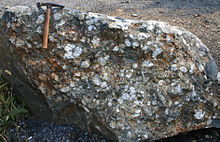The recent press conference on Curiosity's scientific findings announced the discovery of a kind of rock called a 'conglomerate' which is a kind of sedimentary rock consisting of pieces of other rocks (called clasts) bound all together by a cementing matrix.
 |
| Conglomerate boulder (Commons) |
Such rocks can tell us a lot about the kind of environment that they were deposited in; fluvial, glacial, marine and others.If you recall dear reader Curiosity is currently in an area within an alluvial fan and therefore such materials are invaluable to study up close. According to the speakers at the conference, this is the first time they have seen such rocks up close (though they have seen them from orbit in places such as Holden crater).
Three rocks turned out to be conglomerates according to the speakers and they all apparently belong to the same layer of bedrock, starting with the exposed one back at the landing site; the scour mark dubbed 'Goulburn'.
 |
| The scour marks exposed bedrock consisting of conglomerate (NASA/JPL/annotation by me) |
Then there are two others found along the journey to Glenelg; 'Link' named after a rock formation in the Northwest Territories of Canada and 'Hottah' named after the lake in the aforementioned area.
 |
| Hottah looking like a broken up street curb. It is tilted maybe because of shock from a recent meteorite impact. Note the 10cm scale bar. (NASA/JPL/MSSS) |
A close up of Hottah shows protruding clast that has been rounded smooth by erosive forces which are interpreted to be due to water embedded in the matrix consisting of sand-sized material.
 |
| The rounded clast circled in white. The gravel pile to the left are clasts eroded out of the rock by wind erosion probably (NASA/JPL/MSSS) |
Okay so how do we know these rocks were deposited in water and not something else like ice or mud or sand? The speakers talked about key evidence stemming from the size and shape of the clasts. These clasts are relatively big (few centimetres) so that they have been deemed too big to have been carried by something like wind during deposition. Their shape is rounded which is characteristic of rocks found on the banks fast flowing river/streams estimated by the investigators to have been flowing at a 'vigorous' 3ft per second or almost 1m/sec. If the clasts were more angular this wouldn't be conglomerate any more but instead would be something called breccia.
The speakers also pointed out that the valley from which the alluvial fan originates from has been officially named 'Peace vallis' by the International Astronomical Union (IAU) the top body for astronomical nomenclature.
 |
| Peace vallis is seen in the left corner of this elevation map. Bradbury landing is marked with a cross (NASA/JPL/UA) |
Investigating these rocks will be exciting as the clasts represent materials transported by water from the walls of the Gale crater. It is impossible to tell reliably how old these rocks actually are. But an estimate from one of the speakers puts the rounded clasts (that is the time it must have took to smooth them during transportation) at the more than a thousand years mark. Hard to tell without proper dating tools in a terrestrial lab.
So there you have it, 'fossil' (fossil here does not imply bones or remains of living organisms) evidence of a Martian stream. Exciting times! If you would like to learn more about conglomerates, visit this
article on geology.com.
 |
| The rock 'Link' versus a terrestrial example of a conglomerate rock with a known water history (NASA/JPL/MSSS & PSI) |






No comments:
Post a Comment